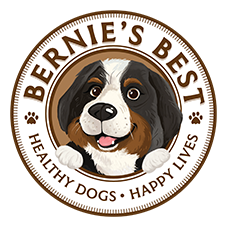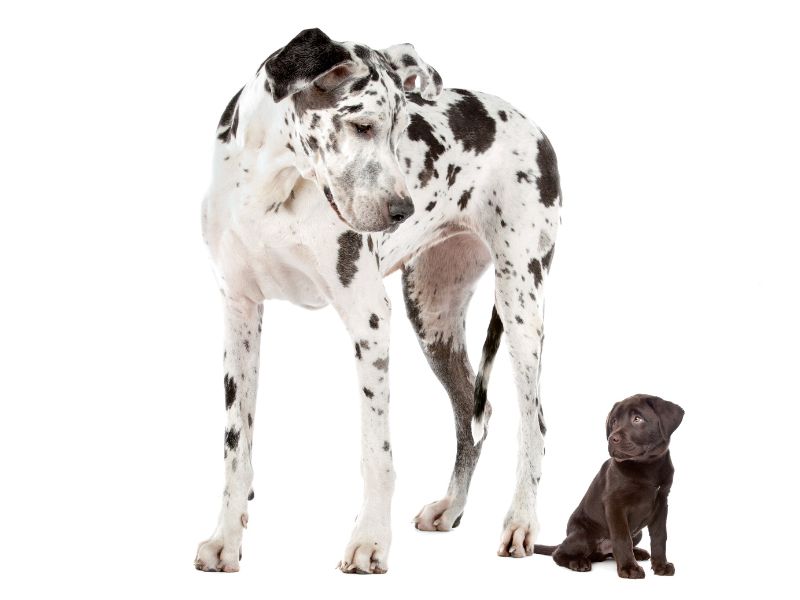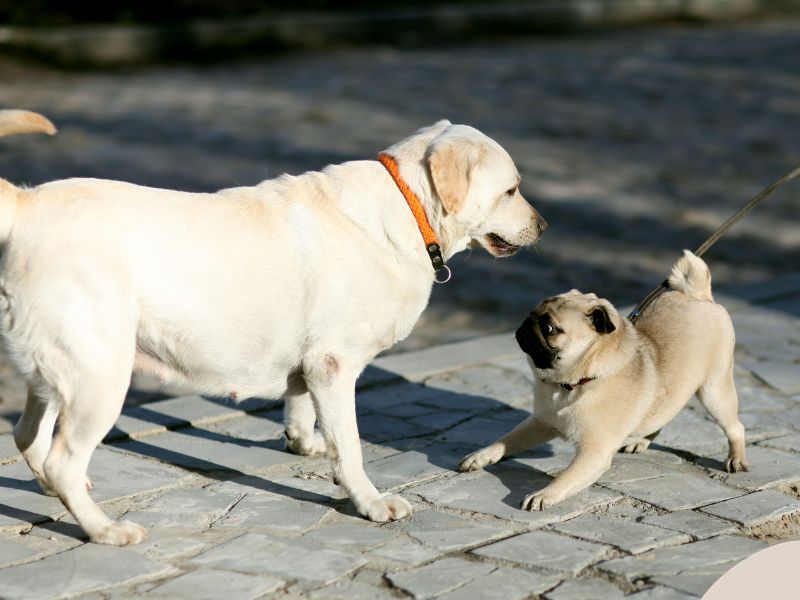Mobility is a crucial aspect of a dog’s life, and impacts their overall well-being and quality of life. When it comes to small-breed dog mobility, their needs and challenges can differ significantly from those of larger breeds. As dog owners, we know that understanding how to enhance their mobility is essential for their long-term health and happiness!
Small Breed Dog Mobility vs Large Breed Dog Mobility
The contrast in mobility between small and large breed dogs is pretty apparent. When you have a chihuahua stand next to a Bernese Mountain Dog, you can safely assume they have different needs. Small breeds, such as Chihuahuas and Yorkshire Terriers, have body structures and health predispositions that uniquely affect their mobility. For example, they are more prone to injuries like kneecap injuries and conditions such as hypoglycemia, which can directly impact their mobility.
Patella Issues in Small Breed Dogs
Small breed dogs have anatomical and physical issues that affect their mobility and their need for joint support.
- Anatomical Predisposition: Small breeds often have a genetic predisposition for patellar luxation, where the kneecap (patella) dislocates from its normal position. Their smaller bones and unique anatomical structures make them more vulnerable to mobility issues stemming from the knee. For example, Pomeranians have a reported patellar luxation risk as high as 75%.
- Comparison with Large Breeds: The incidence of medial patellar luxation in small-breed dogs is reported to be 12 times higher than in large-breed dogs.
- Impact on Mobility: When the patella dislocates, it can cause pain, lameness, or an abnormal gait. This directly affects the dog’s ability to move smoothly and comfortably. Over time, recurrent patellar issues can lead to chronic pain and arthritis. Little bones still get arthritis and suffer from chronic pain that a joint supplement could help.
- Injury Severity: In severe cases, the patella may not return to its normal position without veterinary intervention, severely limiting the dog’s movement and requiring surgical correction.
Hypoglycemia in Small Breed Dogs
Small breeds also have more issues with hypoglycemia, which can negatively affect their mobility.
- Energy Metabolism: Small-breed dogs have a higher metabolic rate and fewer energy reserves due to their smaller size. This makes them more prone to hypoglycemia, or low blood sugar levels, especially if they miss meals or expend a lot of energy.
- Symptoms Affecting Mobility: Hypoglycemia can lead to weakness, lethargy, and even seizures. These symptoms can significantly impair a dog’s mobility, as they may be less inclined or able to move, play, or engage in regular activities.
- Management for Mobility: Proper diet and regular feeding schedules are crucial for preventing hypoglycemia in small breeds. Consistent energy levels help maintain their mobility and overall health.
Puppies and Toy Breeds Susceptibility: Puppies, especially those under 3 months of age, cannot fully regulate their blood glucose levels. Toy breeds are particularly susceptible to hypoglycemia. Things like poor nutrition, cold environments, and intestinal parasites can induce hypoglycemia in puppies. These can all affect their mobility.
Contrast with Large Breeds vs. Smaller Dogs
- Different Health Concerns: Larger breeds like Bernese Mountain dogs or Great Danes face different health challenge propensities, such as hip dysplasia or bloat, which affect their mobility differently than the issues commonly seen in small breeds.
- Structural Differences: The physical structure of larger breeds provides them with a different kind of resilience, but also predisposes them to different types of wear and tear on their joints and bones.
Improving Dog Mobility
Improving dog mobility, particularly in small breeds, involves addressing these unique challenges. Incorporating mobility tips for small dogs into their daily routine can significantly improve their quality of life.
Canine Physical Therapy and Exercise for Small Dog Joint Pain
Physical therapy and regular exercise are vital in enhancing mobility for smaller dogs. Small-breed dogs benefit from specific types of exercise that cater to their size and physical limitations. An exercise routine with activities like swimming and short walks is excellent for keeping their joints healthy without putting too much strain on them. The goal is to keep your smaller dog moving while not doing a physical activity that burdens their bodies excessively. Daily exercise is key, because it also helps with mental stimulation, but their shorter legs mean the exercises other dogs may do might not be the best for them.
Healthy Exercise Routines for Dogs
A daily walk and playtime routine is important for maintaining healthy exercise habits. Contrary to some misconceptions, small dogs require just as much exercise as larger breeds, though the intensity and type of exercise might differ.
How Much Exercise Does a Small Dog Need?
The amount of exercise a small dog needs can vary based on their age, breed, and health. Typically, small dogs should exercise 30 minutes to 2 hours each day, which can be divided into shorter sessions to prevent over-tiredness.
Avoiding Exercise Close to Mealtimes
Exercising a dog close to mealtimes can be harmful due to the risk of Gastric Dilatation-Volvulus (GDV), also known as bloat. This condition can be caused by factors like large meals and vigorous exercise, so it’s important to time your dog’s activities appropriately to prevent such risks. Breed size can make a difference in these conditions, and it’s typically more of a ‘big dog’ condition, but smaller breed-size dogs can still suffer from bloat or GDV.
Senior Small Dog Care and Pet Mobility Solutions
As small breed dogs age, their mobility needs change. Senior small dog care should focus on even gentler exercises and may require pet mobility solutions like specialized harnesses or ramps to aid movement around the home.
Ways to Enhance Mobility in Small Breed Dogs
We can help our small dogs have an active lifestyle with more exercise catered to them and their needs in many ways:
- Use a harness rather than a collar when walking your dog. The less you pull on their neck muscles, the better their mobility and the better the joint care for them.
- Providing ramps and steps if it helps your little pal get to where they want to be. That’ll prevent them from trying to do things that aren’t safe for their little bodies and bones.
- Maintaining a healthy weight to lessen the load on their bones. Yes, even small dogs can be overweight.
- Engaging in short, regular walks for muscle tone building and mental exercise.
- Consider canine physical therapy if it seems your small dog suffers from mobility problems. Their special care can be the difference between Fido learning new tricks that help keep them moving, or struggling with discomfort.
- Offering gentle massage to improve circulation and reduce stiffness.
- Encouraging swimming as a low-impact activity for joint health.
- Providing puzzle toys and obedience training for mental engagement. The less depressed they are, the more they’ll want to move.
- Ensuring they get the right joint supplements tailored to help your dog have the best joint health.
The Role of Joint Supplements For Dogs in Enhancing Mobility
When it comes to the role of nutritional supplements in enhancing mobility in small-breed dogs, it’s essential to look at the latest in canine nutrition and joint health research. While it’s true, we did create Bernie’s Perfect Poop for our large-breed dogs, Bernie’s Marvelous Mobility is an example of a supplement that incorporates a variety of ingredients backed by research to support dog mobility–large dogs and small dogs!
Key Ingredients in Bernie’s Marvelous Mobility and Their Benefits
We’re not afraid to innovate, and when we started looking at the best ingredients for joint supplements for dogs, we found much of the market was designed around older science. Now, we’re not throwing the efficacy of products out simply because of the older science or lack of research, because many vets will tell you that anecdotally, many of the popular joint supplements are a great idea for helping your dog’s joint health. We’re just saying that we wanted to be cutting edge on the latest and greatest science for hip and mobility supplements, and that’s why we used the following ingredients:
- Omega Fatty Acids (Flaxseed Oil, Anchovy Oil, Algal Oil): Omega Fatty Acids are vital for dogs of all sizes, but their benefits may be more pronounced in small breeds due to their higher metabolic rates and susceptibility to skin issues. These fatty acids provide energy, aid in fat-soluble vitamin absorption, and are essential for maintaining healthy skin and coat. They also support a strong immune system and cell growth. Deficiencies can lead to dry, flaky skin. Omega-3 fatty acids, in particular, may be beneficial for dogs with allergic skin disease and have been shown to help with inflammatory joint diseases and skin conditions
- Antioxidants (Astaxanthin, Blueberries): Antioxidants help combat oxidative stress, which can lead to inflammation and joint problems. They can improve learning in older dogs, prevent food spoilage (oxidation), and enhance the taste and nutrient retention of dog food. Antioxidants contribute to a shiny coat, healthy skin, and a robust immune system.
- Anti-Inflammatories (Green Lipped Mussels, Turmeric/Curcumin): Anti-inflammatory agents, such as Green Lipped Mussels and Turmeric/Curcumin, are particularly beneficial for managing joint pain and enhancing dog mobility. Natural anti-inflammatories can include omega-3 fats from oily fish, which have potent effects in
- the body. These components aid in reducing inflammation, which is crucial for maintaining joint health, especially in breeds prone to joint issues.
- Collagens and Proteins (Undenatured Type-II Collagen): Collagens and Proteins, like Undenatured Type-II Collagen, are essential for bone, joint, and gut health in dogs. They maintain strong bones and joints, reduce gut inflammation, and support coat health. Collagen is abundant in dogs’ bodies and is vital for maintaining cartilage, connective tissues, and blood vessels. As dogs age, their collagen production decreases, which can lead to health problems. Supplementing their diet with collagen can reduce joint pain and stiffness, improving mobility.
- Vitamins and Trace Elements (Vitamin K2, Boron): These components support overall health and the function of muscles and joints. These elements are crucial for energy metabolism, skin and coat quality, growth, reproductive performance, and joint and bone integrity. For example, Vitamin D helps maintain phosphorus and calcium balance for healthy bone and muscle growth, and Vitamin E is a valuable antioxidant, particularly in senior pets. Trace minerals like Iron, Selenium, and Zinc are vital for bodily functions, antioxidant defense, and immune system support.
Each of these ingredients has been selected for its potential to support the mobility of all dogs. However, for small dogs, including antioxidants and anti-inflammatories can be particularly beneficial in that they may be more prone to joint stress due to their active nature and propensity for jumping and quick movements.
At Bernie’s Best, we’re all about helping pet parents spend time with their furry family. As much time as they can, and that means keeping them their happiest and healthiest. We aim to enrich dogs’ lives and know that a holistic approach that considers the unique physical and behavioral characteristics of dogs is important
When you understand the differences in small and large breed dogs, and implement the right strategies, including high-quality joint supplements like Bernie’s Marvelous Mobility, you can significantly improve their quality of life. Healthy dogs with happy lives–that’s our goal every day!



